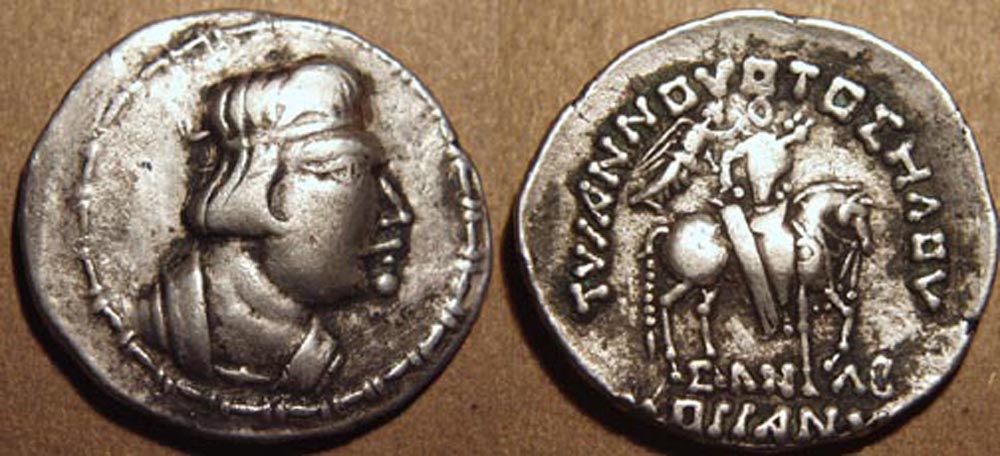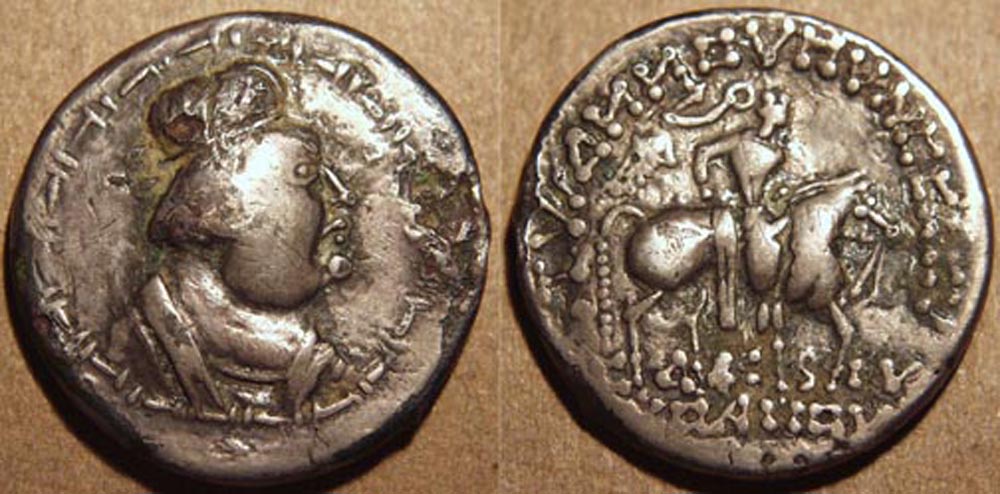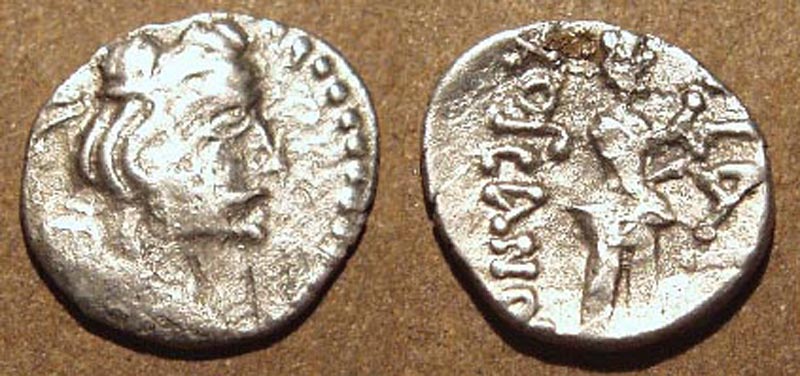
|
|
The coins traditionally assigned to "Heraios," the Kushan, appear to be the first Kushan coins. Joe Cribb of the British Museum has recently argued that these coins were issued by Kujula Kadphises. He bases this argument on two copper coins in the collection of the British Museum that carry a bust right on the obverse, very similar to those on the silver tetradrachms below, and a reverse with Kharoshti legend, where Cribb reads the name of Kujula Kadphises.
The attribution of the Heraios coins to Kujula is attractive, since we had no clear idea who "Heraios" the Kushan was, and Cribb's argument is gaining wide acceptance. However, we would like to be agnostic on this question for the time being. As the coins are rather worn, the reading is by no means certain. Further, even if the reading is correct, we cannot be sure that this means the silver coins were issued by Kujula Kadphises. Just as Kujula issued coins in the style of the Indo-Greek king Hermaios, even leaving Hermaios's name in Greek on the obverse, while introducing his own name in Kharoshti on the reverse, he may have done the same with respect to the coins of "Heraios." Thus the silver coins could have been issued by a Yueh-Chi prince, while the two copper coins at the British Museum could have been issued by Kujula.
Apart from this, there are a number of other unanswered questions that arise if we accept these coins as Kujula's. Why did Kujula not place the same style bust on any of his other coins? Why did the mounted king motif not reappear on any of his other coins? And why did he confine the silver coinage to this one issue (including the obol), itself spread over a fairly long period of time (judging by the way in which style deteriorated over the time span of issue)? Indeed, it seems that the last issues in this series (see the third coin below) may well have been posthumous, and it is hard to imagine that silver coins imitating "Kujula Heraios" were being issued after Kujula's death, when silver had completely disappeared from the Kushan numismatic language. Kujula's son and successor, Vima Takto, issued no silver coins as far as we know.
|

| Silver tetradrachm
c. first half of 1st. Century
Weight:15.53 gm., Diam:29 mm., Die axis: 12h
Diademed bust right within reeded border /
King mounted right, carrying broad-sword
and being crowned by a flying Nike
Greek legend above and below:
TVPANNOYNOTOC HPAOV - ANTEIX - KOPPANOY
Ref: MAC 2836var. |
 |
The normal translation of the legend is: Of the Tyrant (the one who rules by his own power), Heraios, the Kushan. (Note the two P's in KOPPANOY are not rhos, but the Bactrian Greek letters san, and are pronounced "sh.") This type is marked by the very rare ANTEIX in place of the more common ΣANAB (see the next coin); the meaning of this is not clear. Rtveladze has argued that it means "the one who defeats the enemy." (Thanks to Georgiy Nikitin for help translating Rtveladze's article.) |

| Silver tetradrachm
c. first half of 1st. Century
Weight:16.02 gm., Diam:29-32 mm., Die axis: 12h
Diademed bust right within reeded border /
King mounted right, carrying broad-sword
and being crowned by a flying Nike
Greek legend above and below:
TVPANNOVOTOΣ HΛOV - ΣΛNΛB - KOPPANOY
Ref: MAC 2838. |
 |
The significance of the word ΣANAB has never been clear; some think it is a blundering of the word ΣAKA. Rtveladze thinks it is the Iranian translation of ANTEIX. |

| Fouree tetradrachm
c. first half of 1st. Century
Weight:15.34 gm., Diam:29 mm., Die axis: 12h
Diademed bust right within reeded border /
King mounted right, carrying broad-sword
and being crowned by a flying Nike
Greek legend above and below:
TVPANNOVMVN CCAOV - CAt:SIV - KOPANOV
Ref: MAC 2839. |
 |
The debased metal and increasingly blundered legend mark this coin as having been issued late in the series. The legend below the horse has degenerated into what looks like CAt:SIV, another mystery. |

| Silver obol
c. first half of 1st. Century
Weight:0.60 gm., Diam:12 mm., Die axis: 12h
Diademed bust right within dotted border /
Soldier standing right, holding wreath
Greek legend left and right:
HPAOV KOPPANOV
Ref: MAC 2840. |
 |
The reverse of this coin is usually described as depicting a "soldier." However, it is quite likely that the figure represents a deity. |

| Silver obol
c. first half of 1st. Century
Weight:0.54 gm., Diam:12 mm., Die axis: 12h
Diademed bust right within dotted border /
Soldier standing right, holding wreath
Greek legend left and right:
HPAOV KOPPANOV
Ref: MAC 2840. |
|
|